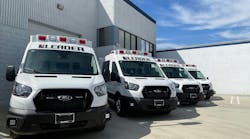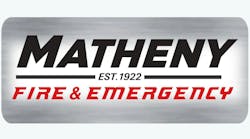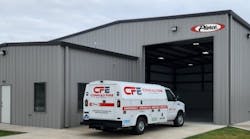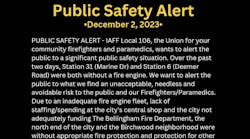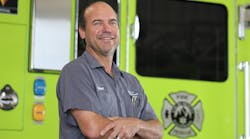The 2018 Emergency Vehicle Technician (EVT) of the Year—Al Hasenfratz, Master EVT with the Sylvania, OH, Fire Department—believes that he has a personal responsibility when working on fire apparatus.
Hasenfratz explained it like this: “Once you start working on [the apparatus] and you meet the crews that are riding the trucks, and you realize they have families, you are responsible for them and all the other people they’re exposed to out on the road, so that’s where I get a lot of motivation, satisfaction and inspiration, actually. It becomes a personal thing.”
Hasenfratz has been a member of the Ohio Association of Emergency Vehicle Technicians (OAEVT) for 13 years and its Northwest Director for nine years. He has held a Master Heavy Duty EVT certification for many years and is also a Master Automotive Service Excellence (ASE) Technician. Hasenfratz serves as an alternate for NFPA 1071: Professional Qualifications of Emergency Vehicle Technicians and is an advisor to the Emergency Vehicle Technician Certification Commission (EVTCC).
I had the pleasure to speak with Hasenfratz about a variety of topics, from the challenges and improvements he’s seen in the industry to advice for other EVTs and fire chiefs.
Wilmoth: How did you get involved in apparatus maintenance?
Hasenfratz: I started about 1980 in the heavy collision repair industry at a body shop for about 10 years. After that I was a chassis technician for an automobile service facility and was challenged to become a field technician for a civil road heavy construction company, repairing heavy equipment.
During a slow period, I followed up on an opportunity with Sylvania Township, which is a suburb of Toledo, where I live. I took the job, which transitioned into taking over the maintenance and repair responsibilities for the fire department. They didn’t really have a comprehensive program in place, and that was kind of my challenge.
At that time, the chief was Chris Maurer, and he encouraged me to pursue training and certification, and he’s the one who pushed me toward the OAEVT. That’s how the how certification process unfolded.
Wilmoth: What’s one of the toughest challenges you face working in your job?
Hasenfratz: Electronics and electrical. Due to the specialized vehicles, most every system on fire apparatus now is electrically controlled or monitored. That’s probably 75 percent of what my job entails other than maintenance and servicing, and things like brakes and oil changes. Electrical is a huge, huge part. And I do enjoy the challenge.
Wilmoth: You've been involved in the industry for a while, and there have been a lot of changes to apparatus. What’s one of the best improvements you’ve seen come along?
Hasenfratz: Electronics. When it works right, it's great, just like the computer at home or on a desk.
Wilmoth: From what we’ve read, you’re quite an advocate in the teaching and mentoring of others. How did that come about?
Hasenfratz: It came about from being involved with OAEVT and, of course, Al Conkle, the executive director. I originally became involved just for the education and the certifications that came along with it, but with the education and the networking, I found a lot of support working on fire apparatus.
After taking part in some of the training seminars, I became more and more involved. The whole group encouraged me to become a director and help with training, so that furthered my education and exposure to more people. Also, I really get a kick out of the students who come in with various experiences and backgrounds. I also really get a kick out of helping that learning process go along. When someone leaves one of the training groups or our symposiums and they learned more than they knew, or they met more people, they take something back to their day-to-day job. I really get a kick out of that.
Wilmoth: I bet that is very satisfying and rewarding.
Hasenfratz: Typically, I try to be like a facilitator. I sit in a lot of classes and take classes for my own certifications, but if you’re sitting in a class and you see people who would like to ask a question but don’t want to really speak up, if you can try and anticipate what they are going to ask and you ask a similar question, that kind of breaks the ice, and then more and more people will take part. But when you see someone’s face light up because they’ve experienced the same problem and you just provided them with more knowledge or the opportunity to figure out how that works, that’s what keeps pulling back to the training part of it.
Wilmoth: What advice do you have for other EVTs, particularly those who are in a supervisory position?
Hasenfratz: I would recommend taking full advantage of all the training you can possibly get, from manufacturers, from training groups, such as OAEVT, Texas has some, and California, and a lot of organizations across the country provide training. The Fire Department Safety Officers Association (FDSOA) has a lot of great training.
I would really support electrical stuff because that has been a common theme throughout my whole process here. It’s what I spend the majority of time on. From a supervisory positon, I would support electrical training and diagnostics; it seems to be that’s what the majority of the industry struggles with.
Another thing I find very important now is all of the firefighter studies on exposures with carcinogens, cancers and drugs and all of things the fire industry is exposed to. As an EVT, I would encourage everyone to protect themselves because the apparatus are also exposed to those hazards. A lot of people don’t realize that when you climb in that fire truck, you could be exposing yourself, so that’s kind of a new deal in the industry, and EVTs don’t recognize it as the hazard that it is.
Wilmoth: We know a number of EVTs with cancer, and the awareness needs to reach anyone in contact with emergency vehicles and apparatus.
Hasenfratz: I was aware of it kind of on the outskirts, but this past September at our training symposium ... was a class called a “clean cab initiative.” … And that was hands down the most informative and shocking class that I took all week. I took three pages of notes. I had no idea this was going on. With all the studies being released, firefighter cancers skyrocketing, occurrences of all these different kinds of cancers, I was stunned to take that all in. So, it definitely changed how I approached fire engines and ambulances now. Absolutely!
Wilmoth: Lastly, what advice do you have for fire chiefs reading this article?
Hasenfratz: It’s from the training and education end of it. When you’re formulating your budgets and looking at your line items, support the training for fire apparatus mechanics. Traditionally that’s always been, “Well, you guys are mechanics, you can fix a lot of things, go ahead.” But with as specialized as these vehicles are, it’s more cost-effective to have an effective training program and have effective technicians working in your shop or in your station. It will save you money in the long run, it will improve safety, and really this whole thing is about safety and preventing line-of-duty deaths.
What was passed onto me when I started down this road was one in four firefighters lose their lives in the line of duty because of vehicle issues. I was shocked by that. Everyone assumes that a nice, shiny fire truck is well maintained, and it turns out they are one of the most poorly maintained vehicles on the road. I was stunned by that. So that’s kind of my motivation, too—to do whatever I can.
EVTs don’t have an eight-hour job where you come to work, work on the same thing all day long and go home. It’s always evolving and changing. I kind of like that.

